 |

|
 |

|
|
|
Rashtrapati Bhavan or
President House.
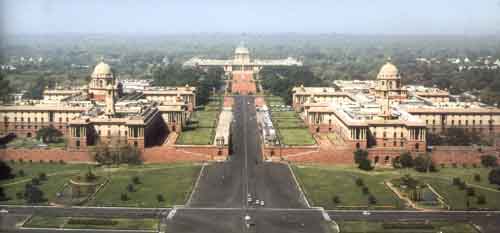 This magnificent building nestled on the Raisina Hill, apart from being the official residence of the President of India, has also played host to numerous heads of state and governments. The National Awards are bestowed in its Durbar Hall. It has one of the largest gardens in the country - the Mughal Gardens spread over 342 acres. The edifice has played a pivotal role in free India. Fifty years after India became a republic, an attempt has been made to give people a chance to peep into the residence of twelve Indian Presidents, two Governor Generals and five Viceroys of the British Raj. Dome Over India---Rashtrapati Bhavan authored and designed by Aman Nath and commissioned by - well - Rashtrapati Bhavan and published by India Book House is a coffee table book on one of the grandest structures of modern India. When the British built it they thought they were going to be in India forever. In the meetings that took place it was decided that though the outside façade would have Indian features the inside would be decidedly British. The building was to be out of bounds for Indians. Alas, that was not to be. The British had to leave India 17 years after it was built. However, the British rulers of India could not foresee their exit which is why they took so much pain in building this grand structure. It was meant to be like Capitol Hill in Washington. Since it was the supposed to be the residence of the imperial ruler it was consciously built at a height. The British wanted the Union Jack to fly over and above everything. Architectural drawings showed it as taller than other highrise buildings of the era like Jama Masjid and the Red Fort. It took eight years to build Rashtrapati Bhavan. World famous architect Edwin Lutyens was given the contract to design the building. The work for its construction commenced in 1913 and its first occupant, Viceroy Lord Irwin moved in on January 23, 1931. 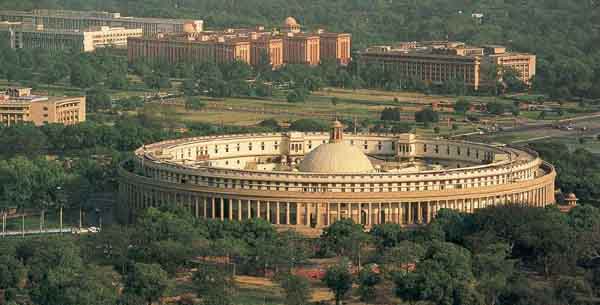 |
 |
| The Statistics
The Rashtrapati Bhavan covers an area of 18,580 sq meters (200,000 square feet). The total cost involved in the construction was Rs. 1.4 million. Over 3,500 men worked on 3.5 million cubic feet of marble. And 1,700 million bricks went into its construction. " At that time it was called the largest stone yard in the world," says author Aman Nath who has earlier done books on Goa and Jaipur and co-authored two books on Rajasthan, one on frescoes of the Shekhawati region and the other on the arts and crafts of the state. " President Narayanan gifted my book on Rajasthan to his daughter for her wedding. He also presented it to President Clinton during his state visit to India in 2000. When I met the President I asked him why should Delhi be presenting a book on Jaipur to visiting dignitaries? We should have a book relevant to Delhi. The President instantly agreed," says Nath Nath had just four months to research and write the book. The work commenced in March 2002 and he had to complete it before President Naryanan’s term came to an end on July 25, 2002 . " Of all my works this was the most ambitious and most challenging. For four months my working day stretched for 18 hours a day," says he. The Dome Over India---Rashtrapati Bhavan priced at Rs. 2000 spreads over 152 text and pictorial pages and dwells on the many facets of Rashtrapati Bhavan. Some pictures offer a panoramic view others an aerial view. The book also has some rare archival pictures of this symbol of Indian architecture. But Nath says, " Edwin Lutyens disliked anything Indian. He had nothing but contempt for Indian architecture. The Rashtrapati Bhavan would have looked like any British building had the then Viceroy Lord Harding not given strict instructions to Lutyens to assimilate the designs from Indian architecture." According to the author, Lord Harding had a very clear idea about the location. He wanted the Rashtrapati Bhavan (then Viceroy House) to be on the Raisina Hills with one axis towards the Purana Quila as it was a blend of Hindu and Muslim cultures and the other axis towards Red Fort as it was a Mughal building." Lutyens worked with another architect, Herbert Baker. Their styles came to be known as Indo-Saracenic architecture. The two relied heavily on existing buildings and styles. Though Lutyens did not admit it, he borrowed heavily from Indian architecture. The dome was a virtual replica of the Sanchi Stupa---the final resting place of the Buddha. The Mughal jalis and motifs were copied from the Diwan-i-Khas in Delhi's Red Fort. 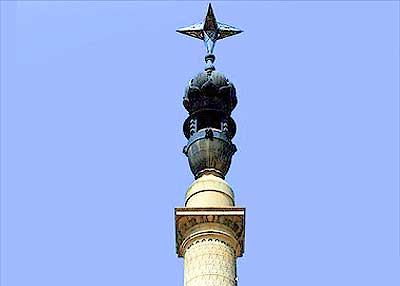 " Rashtrapati Bhavan is an exhibitionist building which has everything huge--- verandahs, balconies and massive columns. It is an imposing structure," says Nath. He feels builders of modern houses can learn a lot from Rashtrapati Bhavan. The book also discusses the work done by the various occupants of the Rashtrapati Bhavan. During the tenure of President R. Venkatraman attention was paid to the art treasures in the Rashtrapati Bhavan. The artefacts are now deposited in a museum which was once upon a time the Viceroy’s private supper room. Similarly, President Narayanan took upon a novel initiative of conservation of water through rain water harvesting with the help of the late environmentalist, Anil Aggarwal. Now the new incumbent, Dr.
A.P.J. Abdul Kalam has many plans which he wants to implement in his own
unconventional style of functioning.
The splendour of the Rashtrapati Bhavan is multi-dimensional. It is a vast mansion and its architecture is breathtaking. More than these, it has a hallowed existence in the annals of democracy for being the residence of the President of the largest democracy in the world. Few official residential premises of the Head of theState in the world will match the Rashtrapati Bhavan in terms of its size, vastness and its magnificence. The present day Rashtrapati Bhavan was the erstwhile residence of the British Viceroy. Its architect was Edwin Landseer Lutyens. The decision to build a residence in New Delhi for the British Viceroy was taken after it was decided in the Delhi Durbar of 1911 that the capital of India would be shifted from Calcutta to Delhi in the same year. It was constructed to affirm the permanence of British rule in India. This building gave the impression, in the words of a critique, the setting of a perpetual Durbar. The building and its surroundings were supposed to be 'an empire in stone', 'exercising imperial sway' and containing in it, "the abode of a disinterested elite whose rule was imposed from above". That 'empire in stone' and the perpetual Durbar was transformed to be the permanent institution of democracy on 26th January 1950 when Dr. Rajendra Prasad became the first President of India and occupied this building to preserve, protect and defend the Constitution of India. It was from that day that this building was renamed as Rashtrapati Bhavan - the President's House. 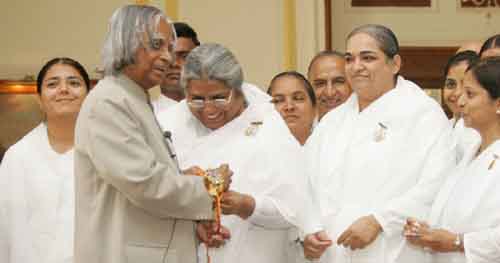 The sanctioned amount for the building was earmarked at £400, 000. However the long span of seventeen years required for the construction of the building raised its cost to £877,136 (then Rs. 12.8 million). The actual amount incurred in not only the construction of the building but also the Mughal Garden and the staff quarters amounted to Rs. 14 million. Edwin Lutyens was reported to have remarked that the money invested in the construction of the building was smaller in amount as compared to the cost of two warships. It is interesting to note that the building which was scheduled to be completed in four years took seventeen years and on the eighteenth year of its completion India became independent. This vast mansion has got four floors and 340 rooms. With a floor area of 200, 000 square feet it is built by using 700 million bricks and three million cubic feet of stone. Hardly any steel has gone into the construction of the building. The most prominent and distinguishing aspect of Rashtrapati Bhavan is its dome which is superimposed on its structure. It is visible from a distance and the most eye-catching round roof with a circular base in the heart of Delhi. While Lutyens ostensibly acknowledged the design of the dome to the pantheon of the Rome, it is very strongly believed by informed analysts that the dome was structured in the pattern of the great Stupa at Sanchi. The pre-dominance of Indian architecture in the dome is evident from the fact that it is encircled by railings of Sanchi origin. In fact the whole of Rashtrapati Bhavan embodies in it Indian architectural patterns such as Buddhist railings, chhajjas, chhatris and jaalis. 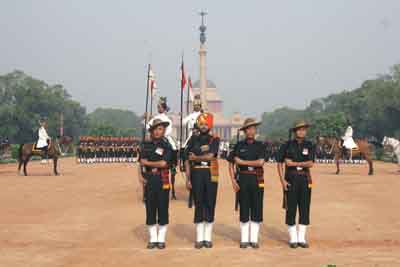
The might and authority of the people of India, which pervades this Republic is represented by the President of the country, whose official residence is the Rashtrapati Bhavan and the architecture of which fascinates as much the ardent architects as the common people across the globe. 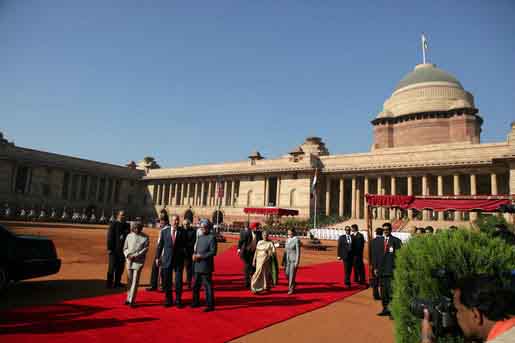 The main structure is 640 feet wide and its sides are 540 feet deep (roughly 195 by 165 meters). The circumference at the base is a kilometere long. There is a vast court in front, T-shaped, with the horizontal line aligned with the front of the building. In the center of this jutting section stands the Jaipur Column, 145 feet(44.2 meters), topped by a bronze lotus from which rises a six-pointed glass star. The name of the column comes from the fact that its cost was borne by the Maharaja of Jaipur. An intresting details about the column is that inside the stone shaft runs a steel tube which tethers the lotus and the star, which weigh a little more than five tonnes, to a concrete block in the foundation. On the base of the column are inscribed the following 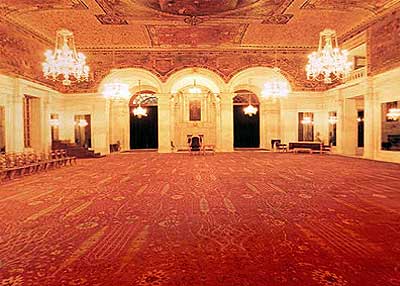 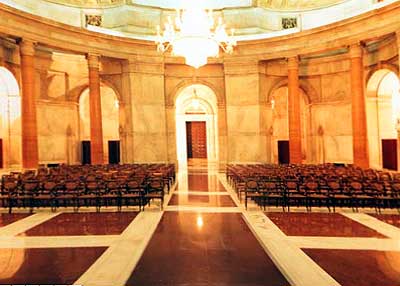 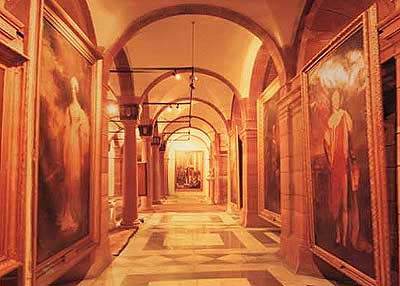 |